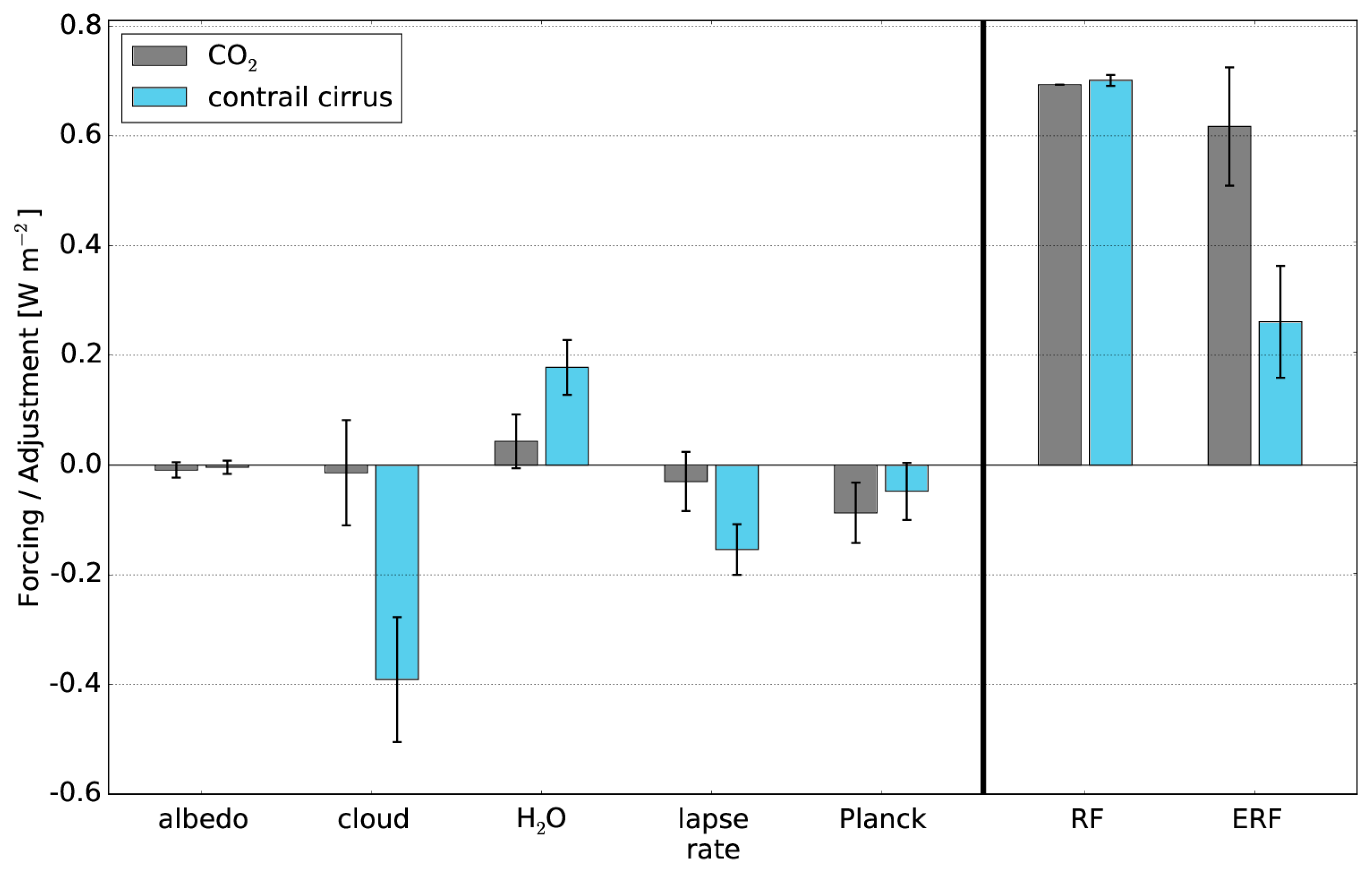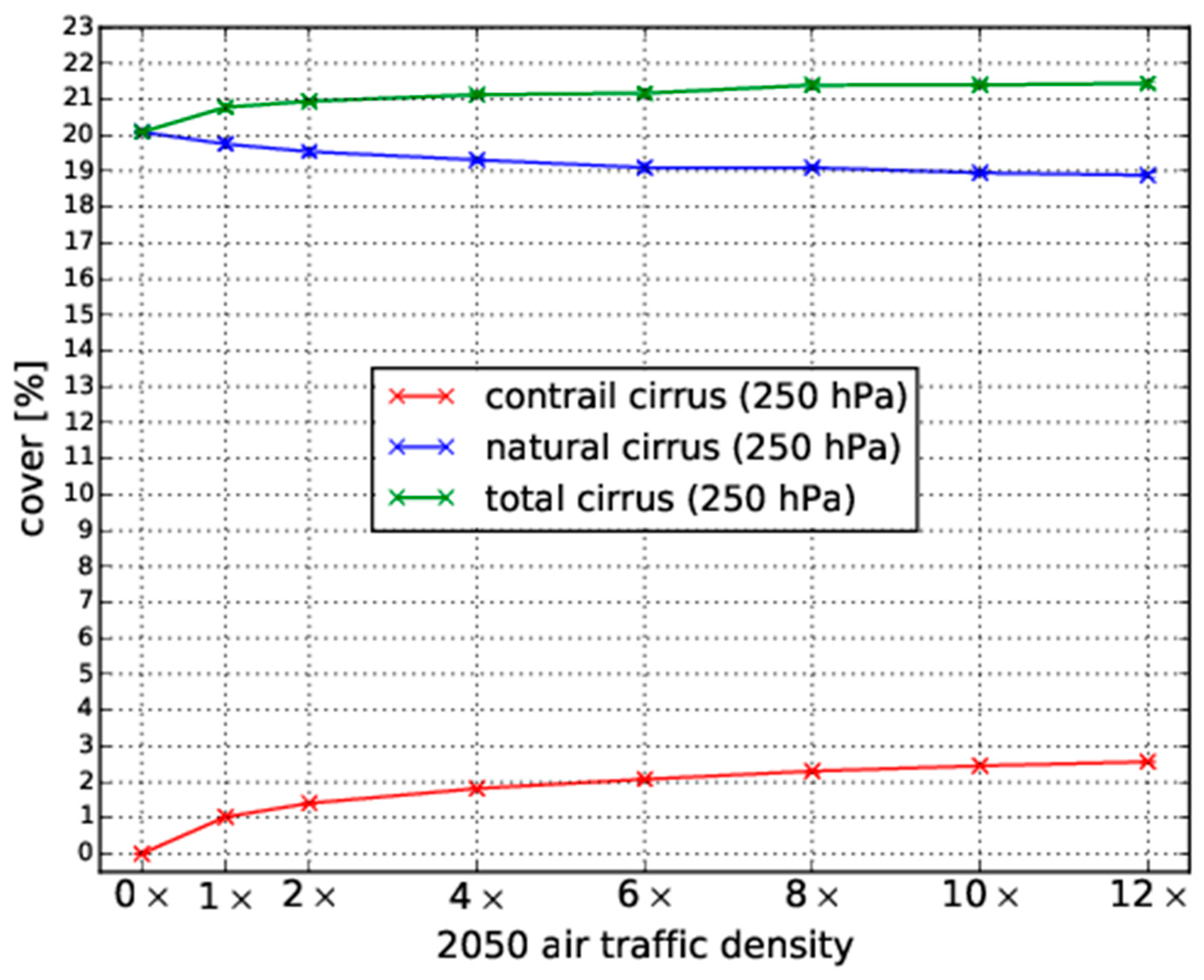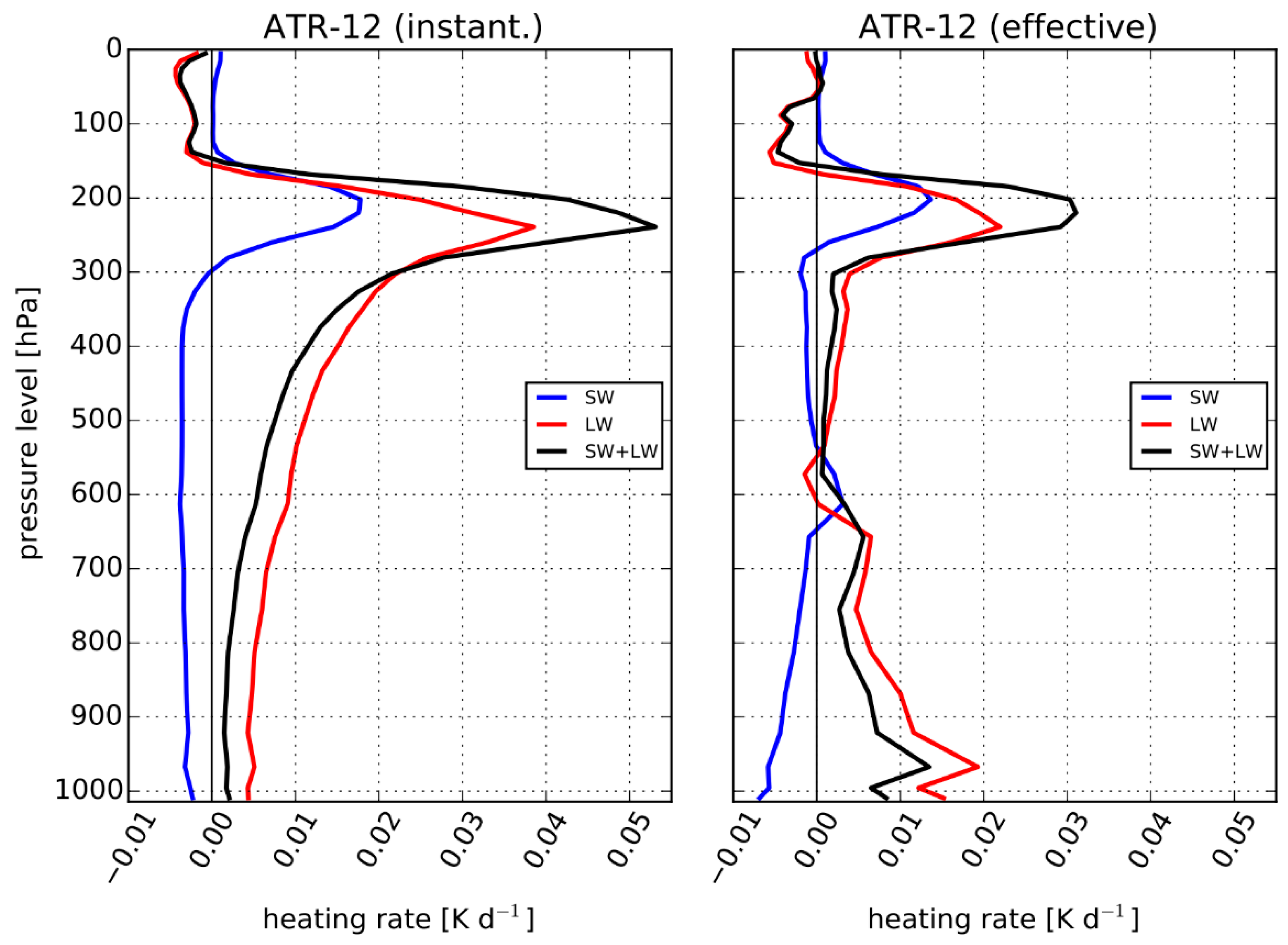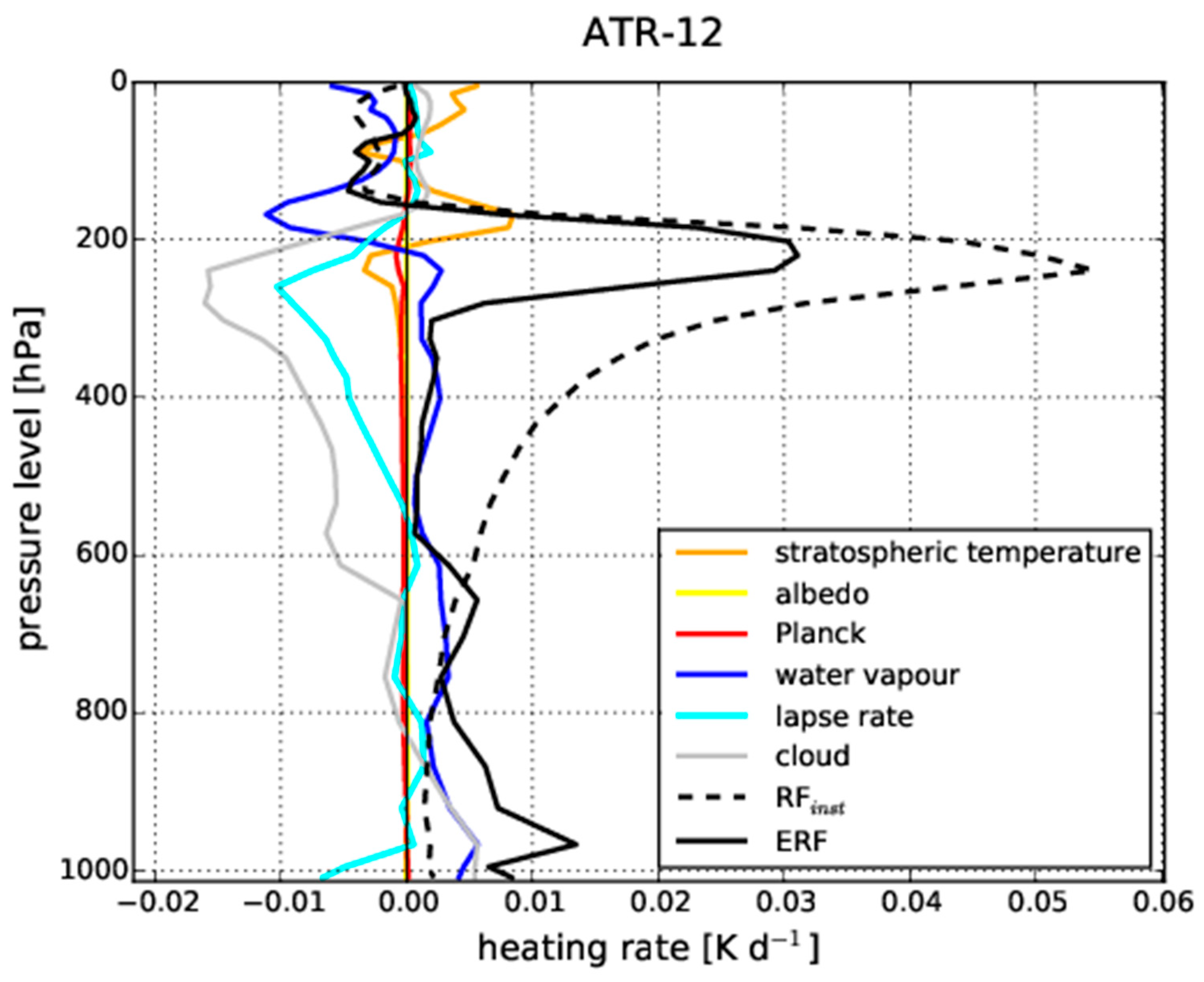Towards Determining the Contrail Cirrus Efficacy
Abstract
1. Introduction
2. Simulation Concept and ERF Results
3. Analysis of Rapid Radiative Adjustments
4. Is the ERF/RF Ratio a Reliable Substitute for Contrail Cirrus Efficacy?
5. Approaching the Direct Determination of Contrail Cirrus Efficacy
6. Concluding Discussion and Outlook
Author Contributions
Funding
Institutional Review Board Statement
Informed Consent Statement
Data Availability Statement
Acknowledgments
Conflicts of Interest
References
- Burkhardt, U.; Kärcher, B. Global radiative forcing from contrail cirrus. Nat. Clim. Change 2011, 1, 54–58. [Google Scholar] [CrossRef]
- Schumann, U.; Graf, K. Aviation induced cirrus and radiation changes at diurnal timescales. J. Geophys. Res. Atmos. 2013, 118, 2404–2421. [Google Scholar] [CrossRef]
- Bock, L.; Burkhardt, U. Reassessing properties and radiative forcing of contrail cirrus using a climate model. J. Geophys. Res. Atmos. 2016, 121, 9717–9736. [Google Scholar] [CrossRef]
- Kärcher, B. Formation and radiative forcing of contrail cirrus. Nat. Comm. 2018, 9, 1824. [Google Scholar] [CrossRef]
- Myhre, G.; Shindell, D.T.; Bréon, F.; Collins, W.; Fuglestvedt, J.S.; Huang, J.; Koch, D.; Lamarque, J.-F.; Lee, D.S.; Mendoza, B.; et al. Anthropogenic and natural radiative forcing. In Climate Change 2013: The Physical Science Basis. Contribution of Working Group I to the fifth Assessment Report of the Intergovernmental Panel on Climate Change; Stocker, T.F., Qin, D., Plattner, G.-K., Tignor, M., Allen, S.K., Boschung, J., Nauels, A., Xia, Y., Bex, V., Midgley, P.M., Eds.; Cambridge University Press: Cambridge, UK; New York, NY, USA, 2013; pp. 659–740. [Google Scholar]
- Ramaswamy, V.; Collins, W.; Haywood, J.; Lean, J.; Mahowald, N.; Myhre, G.; Naik, V.; Shine, K.P.; Soden, B.; Stenchikov, G.; et al. A century of progress in atmospheric and related sciences: Celebrating the American Meteorological Society Centennial. Meteor. Monogr. 2019, 59, 14.1–14.101. [Google Scholar] [CrossRef]
- Hansen, J.; Sato, M.; Ruedy, R.; Nazarenko, L.; Lacis, A.; Schmidt, G.A.; Russell, G.; Aleinov, I.; Bauer, M.; Bauer, S.; et al. Efficacy of climate forcings. J. Geophys. Res. 2005, 110, D18104. [Google Scholar] [CrossRef]
- Boer, M.; Yu, B. Climate sensitivity and response. Clim. Dyn. 2003, 20, 415–429. [Google Scholar] [CrossRef]
- Bony, S.; Colman, R.; Kattsov, V.M.; Allan, R.P.; Bretherton, C.S.; Dufresne, J.-L.; Hall, A.; Hallegatte, S.; Holland, M.M.; Ingram, W.; et al. How well do we understand and evaluate climate change processes? J. Clim. 2006, 19, 2445–2482. [Google Scholar] [CrossRef]
- Soden, B.J.; Held, I.M. An assessment of climate feedbacks in ocean-atmosphere models. J. Clim. 2006, 19, 3345–3360. [Google Scholar] [CrossRef]
- Rieger, V.; Dietmüller, S.; Ponater, M. Can feedback analysis be used to uncover the physical origin of climate sensitivity and efficacy differences? Clim. Dyn. 2017, 49, 2831–2844. [Google Scholar] [CrossRef]
- Richardson, T.B.; Forster, P.M.; Smith, P.J.; Maycock, A.C.; Wood, T.; Andrews, T.; Boucher, O.; Faluvegi, G.; Fläschner, D.; Hodnebrog, Ø.; et al. Efficacy of climate forcings in PDRMIP models. J. Geophys. Res. Atmos. 2019, 124, 12824–12844. [Google Scholar] [CrossRef]
- Marvel, K.; Schmidt, G.A.; Miller, R.L.; Nazarenko, E.S. Implications for climate sensitivity from the response of individual forcings. Nat. Clim. Chang. 2016, 6, 389. [Google Scholar] [CrossRef]
- Ponater, M.; Marquart, S.; Sausen, R.; Schumann, U. On contrail climate sensitivity. Geophys. Res. Lett. 2005, 32, L10706. [Google Scholar] [CrossRef]
- Rap, A.; Forster, P.M.; Haywood, J.; Jones, A.; Boucher, O. Estimating the climate effect of contrails using the UK met office climate model. Geophys. Res. Lett. 2010, 37, L20703. [Google Scholar] [CrossRef]
- Bickel, M.; Ponater, M.; Bock, L.; Burkhardt, U.; Reineke, S. Estimating the effective radiative forcing of contrail cirrus. J. Clim. 2020, 33, 1991–2005. [Google Scholar] [CrossRef]
- Schumann, U.; Mayer, B.; Graf, K.; Mannstein, H. A parametric radiative forcing model for contrail cirrus. J. Appl. Meteor. Climatol. 2012, 51, 1391–1406. [Google Scholar] [CrossRef]
- Chung, E.-S.; Soden, B.J. An assessment of methods for computing radiative forcing in climate models. Environ. Res. Lett. 2015, 10, 074004. [Google Scholar] [CrossRef]
- Dietmüller, S.; Jöckel, P.; Tost, H.; Kunze, M.; Gellhorn, C.; Brinkop, S.; Frömming, C.; Ponater, M.; Steil, B.; Lauer, A.; et al. A new radiation infrastructure for the Modular Earth Submodel System (MESSy, based on version 2.51). Geosci. Model Dev. 2016, 9, 2209–2222. [Google Scholar] [CrossRef]
- Forster, P.M.; Richardson, T.B.; Smith, P.J.; Maycock, A.C.; Samset, B.H.; Myhre, G.; Andrews, T.; Pincus, R.; Schulz, M. Recommendations for diagnosing effective radiative forcing from climate models for CMIP6. J. Geophys. Res. Atmos. 2016, 124, 12824–12844. [Google Scholar] [CrossRef]
- Myhre, G.; Kvalevåg, M.; Rädel, G.; Cook, J.; Shine, K.P.; Clark, H.; Karcher, F.; Markowicz, K.; Kardas, A.; Wolkenberg, P.; et al. Intercomparison of radiative forcing calculations of stratospheric water vapour and contrails. Meteorol. Z. 2009, 18, 585–596. [Google Scholar] [CrossRef]
- Lee, D.S.; Pitari, G.; Grewe, V.; Gierens, K.; Penner, J.L.; Petzold, A.; Prather, M.J.; Schumann, U.; Bais, A.; Berntsen, T.; et al. Transport impacts on atmosphere and climate: Aviation. Atmos. Environ. 2010, 44, 4678–4734. [Google Scholar] [CrossRef] [PubMed]
- Chen, C.; Gettelman, A. Simulated radiative forcing from contrails and contrail cirrus. Atmos. Chem. Phys. 2013, 13, 12525–12536. [Google Scholar] [CrossRef]
- Lee, D.S.; Fahey, D.W.; Skowron, A.; Allen, M.R.; Burkhardt, U.; Chen, Q.; Doherty, S.J.; Freeman, S.; Forster, P.M.; Fuglestvedt, J.S.; et al. The contribution of global aviation to anthropogenic climate forcing for 2010 to 2018. Atmos. Environ. 2021, 244, 117834. [Google Scholar] [CrossRef]
- Bock, L.; Burkhardt, U. The temporal evolution of a long-lived contrail cirrus cluster: Simulations with a global climate model. J. Geophys. Res. Atmos. 2016, 121, 3548–3565. [Google Scholar] [CrossRef]
- Bock, L.; Burkhardt, U. Contrail radiative forcing for future air traffic. Atmos. Chem. Phys. 2019, 19, 8163–8174. [Google Scholar] [CrossRef]
- Wilkerson, J.; Jacobsen, M.Z.; Malwitz, A.; Balasubramanian, S.; Wayson, R.; Fleming, G.; Naiman, A.D.; Lele, S.K. Analysis of emission data from global commercial aviation: 2004 and 2006. Atmos. Chem. Phys. 2010, 10, 6391–6408. [Google Scholar] [CrossRef]
- Fuglestvedt, J.S.; Berntsen, T.; Myhre, G.; Rypdal, K.; Bielveldt-Skeie, R. Climate forcing from the transport sectors. Proc. Nat. Acad. Sci. USA 2008, 105, 454–458. [Google Scholar] [CrossRef]
- Smith, P.J.; Kramer, R.J.; Myhre, G.; Forster, P.M.; Soden, B.J.; Andrews, T.; Boucher, O.; Faluvegi, G.; Fläschner, D.; Hodnebrog, Ø.; et al. Understanding rapid adjustments to diverse forcing agents. Geophys. Res. Lett. 2018, 45, 12023–12031. [Google Scholar] [CrossRef]
- Sherwood, S.C.; Webb, M.J.; Annan, J.D.; Arman, K.C.; Forster, P.M.; Hargreaves, J.C.; Hegerl, G.; Klein, S.A.; Marvel, K.D.; Rohling, E.J.; et al. An assessment of Earth’s climate sensitivity using multiple lines of evidence. Rev. Geophys. 2020, 58, 1–92. [Google Scholar] [CrossRef]
- Frömming, C.; Ponater, M.; Dahlmann, K.; Grewe, V.; Lee, D.; Sausen, R. Aviation induced radiative forcing and surface temperature change in dependency of emission altitude. J. Geophys. Res. Atmos. 2012, 117, D19104. [Google Scholar] [CrossRef]
- Teoh, R.; Schumann, U.; Stettler, M.E.J. Beyond contrail avoidance: Efficacy of flight altitude changes to minimise contrail climate forcing. Aerospace 2020, 7, 121. [Google Scholar] [CrossRef]
- Matthes, S.; Lührs, B.; Dahlmann, K.; Grewe, V.; Linke, F.; Yin, F.; Klingaman, E.; Shine, K.P. Climate optimized trajectories and robust mitigation potential: Flying ATM4E. Aerospace 2020, 7, 156. [Google Scholar] [CrossRef]
- Shine, K.P.; Highwood, E.J.; Rädel, G.; Stuber, N.; Balkanski, Y. Climate model simulations of the impact of aerosols from road transport and shipping. Atmos. Oceanic Opt. 2012, 25, 62–70. [Google Scholar] [CrossRef]
- Meerkötter, R.; Schumann, U.; Doelling, D.R.; Minnis, P.; Nakajima, T.; Tsushima, Y. Radiative forcing by contrails. Ann. Geophysicae Atmos. Hydro. Space Sci. 1999, 17, 1080–1097. [Google Scholar]
- Ponater, M.; Marquart, S.; Sausen, R. Contrails in a comprehensive global climate model: Parameterization and radiative forcing results. J. Geophys. Res. 2002, 107, 4164. [Google Scholar] [CrossRef]
- Dietmüller, S.; Ponater, M.; Sausen, R.; Hoinka, K.-P.; Pechtl, S. Contrails, natural clouds, and diurnal temperature range. J. Clim. 2008, 21, 5061–5075. [Google Scholar] [CrossRef]
- Schumann, U.; Mayer, B. Sensitivity of surface temperature to radiative forcing by contrail cirrus in a radiative-mixing model. Atmos. Chem. Phys. 2017, 17, 13833–13848. [Google Scholar] [CrossRef]
- Lee, D.S.; Fahey, D.W.; Forster, P.M.; Newton, P.J.; Wit, R.C.N.; Lim, L.L.; Owen, B.; Sausen, R. Aviation and global climate change in the 21st century. Atmos. Environ. 2009, 43, 3520–3537. [Google Scholar] [CrossRef]
- Zelinka, M.D.; Taylor, K.E.; Andrews, T.; Webb, M.J.; Gregory, J.M.; Forster, P.M. Contributions of different cloud types to feedbacks and rapid adjustments in CMIP5. J. Clim. 2013, 26, 5007–5027. [Google Scholar] [CrossRef]





Publisher’s Note: MDPI stays neutral with regard to jurisdictional claims in published maps and institutional affiliations. |
© 2021 by the authors. Licensee MDPI, Basel, Switzerland. This article is an open access article distributed under the terms and conditions of the Creative Commons Attribution (CC BY) license (http://creativecommons.org/licenses/by/4.0/).
Share and Cite
Ponater, M.; Bickel, M.; Bock, L.; Burkhardt, U. Towards Determining the Contrail Cirrus Efficacy. Aerospace 2021, 8, 42. https://doi.org/10.3390/aerospace8020042
Ponater M, Bickel M, Bock L, Burkhardt U. Towards Determining the Contrail Cirrus Efficacy. Aerospace. 2021; 8(2):42. https://doi.org/10.3390/aerospace8020042
Chicago/Turabian StylePonater, Michael, Marius Bickel, Lisa Bock, and Ulrike Burkhardt. 2021. "Towards Determining the Contrail Cirrus Efficacy" Aerospace 8, no. 2: 42. https://doi.org/10.3390/aerospace8020042
APA StylePonater, M., Bickel, M., Bock, L., & Burkhardt, U. (2021). Towards Determining the Contrail Cirrus Efficacy. Aerospace, 8(2), 42. https://doi.org/10.3390/aerospace8020042





